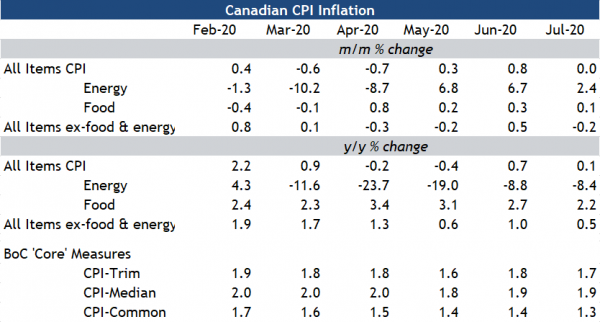- Headline CPI growth slowed to 0.1% year-over-year in July
- Ex-food and energy price growth slowed to 0.5% from a year ago
- Long-run inflationary pressure muted, demand shortfall weighing on prices of services
Canada’s inflation rate edged lower in July after bouncing back surprisingly sharply in June from sub-zero year-over-year readings in April and May. Higher energy prices were offset by lower services inflation, leaving the headline index just 0.1% above its year-ago level, down from 0.7% in June. Food prices continued to increase at an above-average pace although slowed to 2.2% year-over-year from a recent peak of 3.4% in April. Gasoline prices continued to increase from lows in the spring although were still down 15% from a year ago.
Outside food and energy components, price growth slowed to 0.5% on a year-over-year basis in July. The Bank of Canada’s preferred core measures edged lower as well, on balance after unexpectedly ticking up in June. The three measures (“trim”, “median”, and “common”) averaged 1.6% in July, down from 1.7% the prior month. Overall services inflation slowed to just 0.5% year-over-year, the lowest ever for the series. Weaker services demand – particular for travel-related components – contributed to the slowing. By our count, travel services and inter-city transportation components together worked to subtract 0.4 ppts off of the headline year-over-year growth rate in July.
To-date, a slow and cautious reopening of the economy has served Canada well in terms of helping avoid the same type of resurgence in COVID-19 cases as in the US and some EU countries. But it is also keeping a lid on demand, particularly in travel-related services. To-date the economy is still operating well-below capacity, and will continue to do so while the threat of the virus remains. That should keep the BoC free to maintain interest rates exceptionally low. Indeed, in their July MPR, the central bank projected that CPI will remain below the 2% target even by the end of 2022, while reiterating their conditional commitment to maintain the policy rate low “until economic slack is absorbed so that the 2 percent inflation target is sustainably achieved.”














